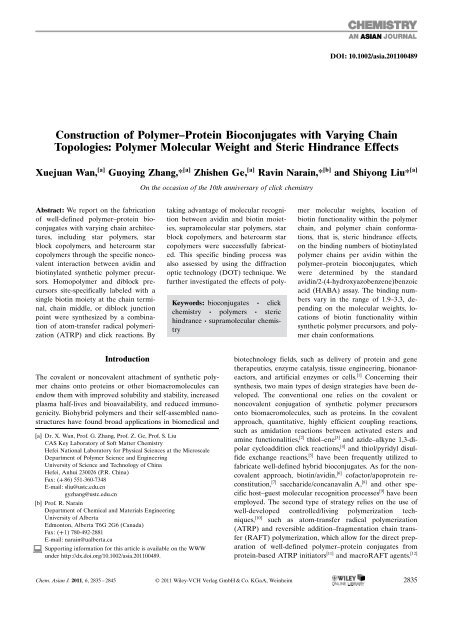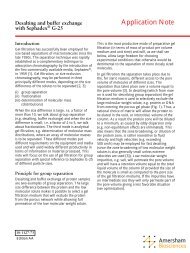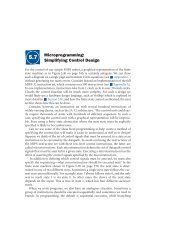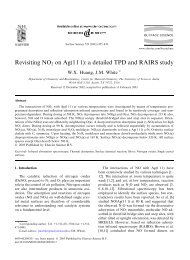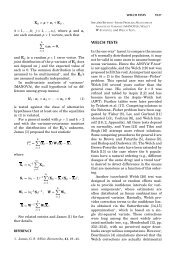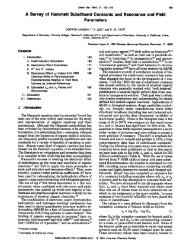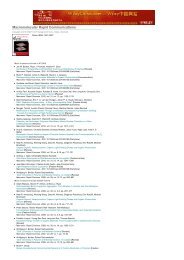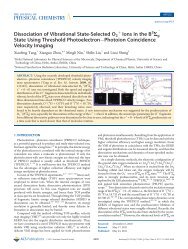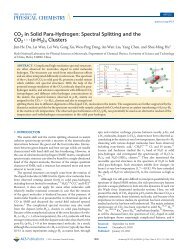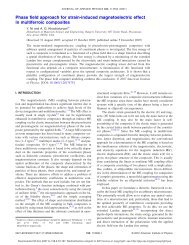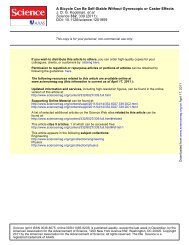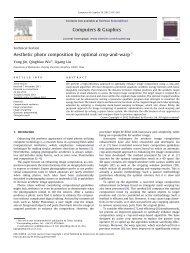Polymer Molecular Weight and Steric Hindrance Effect
Polymer Molecular Weight and Steric Hindrance Effect
Polymer Molecular Weight and Steric Hindrance Effect
Create successful ePaper yourself
Turn your PDF publications into a flip-book with our unique Google optimized e-Paper software.
DOI: 10.1002/asia.201100489<br />
Construction of <strong>Polymer</strong>–Protein Bioconjugates with Varying Chain<br />
Topologies: <strong>Polymer</strong> <strong>Molecular</strong> <strong>Weight</strong> <strong>and</strong> <strong>Steric</strong> <strong>Hindrance</strong> <strong>Effect</strong>s<br />
Xuejuan Wan, [a] Guoying Zhang,* [a] Zhishen Ge, [a] Ravin Narain,* [b] <strong>and</strong> Shiyong Liu* [a]<br />
Abstract: We report on the fabrication<br />
of well-defined polymer–protein bioconjugates<br />
with varying chain architectures,<br />
including star polymers, star<br />
block copolymers, <strong>and</strong> heteroarm star<br />
copolymers through the specific noncovalent<br />
interaction between avidin <strong>and</strong><br />
biotinylated synthetic polymer precursors.<br />
Homopolymer <strong>and</strong> diblock precursors<br />
site-specifically labeled with a<br />
single biotin moiety at the chain terminal,<br />
chain middle, or diblock junction<br />
point were synthesized by a combination<br />
of atom-transfer radical polymerization<br />
(ATRP) <strong>and</strong> click reactions. By<br />
Introduction<br />
The covalent or noncovalent attachment of synthetic polymer<br />
chains onto proteins or other biomacromolecules can<br />
endow them with improved solubility <strong>and</strong> stability, increased<br />
plasma half-lives <strong>and</strong> bioavailability, <strong>and</strong> reduced immunogenicity.<br />
Biohybrid polymers <strong>and</strong> their self-assembled nanostructures<br />
have found broad applications in biomedical <strong>and</strong><br />
[a] Dr. X. Wan, Prof. G. Zhang, Prof. Z. Ge, Prof. S. Liu<br />
CAS Key Laboratory of Soft Matter Chemistry<br />
Hefei National Laboratory for Physical Sciences at the Microscale<br />
Department of <strong>Polymer</strong> Science <strong>and</strong> Engineering<br />
University of Science <strong>and</strong> Technology of China<br />
Hefei, Anhui 230026 (P.R. China)<br />
Fax: (+ 86) 551-360-7348<br />
E-mail: sliu@ustc.edu.cn<br />
gyzhang@ustc.edu.cn<br />
[b] Prof. R. Narain<br />
Department of Chemical <strong>and</strong> Materials Engineering<br />
University of Alberta<br />
Edmonton, Alberta T6G 2G6 (Canada)<br />
Fax: (+ 1) 780-492-2881<br />
E-mail: narain@ualberta.ca<br />
Supporting information for this article is available on the WWW<br />
under http://dx.doi.org/10.1002/asia.201100489.<br />
On the occasion of the 10th anniversary of click chemistry<br />
taking advantage of molecular recognition<br />
between avidin <strong>and</strong> biotin moieties,<br />
supramolecular star polymers, star<br />
block copolymers, <strong>and</strong> heteroarm star<br />
copolymers were successfully fabricated.<br />
This specific binding process was<br />
also assessed by using the diffraction<br />
optic technology (DOT) technique. We<br />
further investigated the effects of poly-<br />
Keywords: bioconjugates · click<br />
chemistry · polymers · steric<br />
hindrance · supramolecular chemistry<br />
mer molecular weights, location of<br />
biotin functionality within the polymer<br />
chain, <strong>and</strong> polymer chain conformations,<br />
that is, steric hindrance effects,<br />
on the binding numbers of biotinylated<br />
polymer chains per avidin within the<br />
polymer–protein bioconjugates, which<br />
were determined by the st<strong>and</strong>ard<br />
avidin/2-(4-hydroxyazobenzene)benzoic<br />
acid (HABA) assay. The binding numbers<br />
vary in the range of 1.9–3.3, depending<br />
on the molecular weights, locations<br />
of biotin functionality within<br />
synthetic polymer precursors, <strong>and</strong> polymer<br />
chain conformations.<br />
biotechnology fields, such as delivery of protein <strong>and</strong> gene<br />
therapeutics, enzyme catalysis, tissue engineering, bionanoreactors,<br />
<strong>and</strong> artificial enzymes or cells. [1] Concerning their<br />
synthesis, two main types of design strategies have been developed.<br />
The conventional one relies on the covalent or<br />
noncovalent conjugation of synthetic polymer precursors<br />
onto biomacromolecules, such as proteins. In the covalent<br />
approach, quantitative, highly efficient coupling reactions,<br />
such as amidation reactions between activated esters <strong>and</strong><br />
amine functionalities, [2] thiol–ene [3] <strong>and</strong> azide–alkyne 1,3-dipolar<br />
cycloaddition click reactions, [4] <strong>and</strong> thiol/pyridyl disulfide<br />
exchange reactions, [5] have been frequently utilized to<br />
fabricate well-defined hybrid bioconjugates. As for the noncovalent<br />
approach, biotin/avidin, [6] cofactor/apoprotein reconstitution,<br />
[7] saccharide/concanavalin A, [8] <strong>and</strong> other specific<br />
host–guest molecular recognition processes [9] have been<br />
employed. The second type of strategy relies on the use of<br />
well-developed controlled/living polymerization techniques,<br />
[10]<br />
such as atom-transfer radical polymerization<br />
(ATRP) <strong>and</strong> reversible addition–fragmentation chain transfer<br />
(RAFT) polymerization, which allow for the direct preparation<br />
of well-defined polymer–protein conjugates from<br />
protein-based ATRP initiators [11] <strong>and</strong> macroRAFT agents. [12]<br />
Chem. Asian J. 2011, 6, 2835 – 2845 2011 Wiley-VCH Verlag GmbH & Co. KGaA, Weinheim 2835
FULL PAPERS<br />
Of the above approaches, the strong, specific, noncovalent<br />
interaction between avidin <strong>and</strong> biotin, upon appropriate<br />
functionalization with a synthetic polymer chain segment,<br />
was often employed to construct supramolecular synthetic<br />
polymer–protein hybrid bioconjugates. [13] Compared with<br />
the covalent approach, noncovalent ones are less disruptive<br />
to the native protein conformation <strong>and</strong> relevant biological<br />
activities. Avidin contains four binding sites for biotin, <strong>and</strong><br />
the biotin/avidin pair possesses a high binding affinity with<br />
Kd values up to 10 15 m. However, it has been reported that<br />
biotinylated polymers, depending on their molecular weight<br />
(MW) <strong>and</strong> chain topology, typically possess decreased affinity<br />
for avidin. Previously, Maynard et al. reported the fabrication<br />
of polymer/avidin bioconjugates by either direct<br />
ATRP from avidin-based initiators or noncovalent conjugation<br />
between avidin <strong>and</strong> biotinylated poly(N-isopropylacrylamide)<br />
(PNIPAM). [14]<br />
In the latter case, the binding<br />
number of PNIPAM chain per avidin was quantified to be<br />
3.6; thus, supramolecular star polymers possessing an avidin<br />
core <strong>and</strong> about three to four PNIPAM arms were prepared.<br />
Haddleton et al. <strong>and</strong> Frey et al. fabricated poly(amidoamine)<br />
(PAMAM) dendrimer <strong>and</strong> linear-dendritic diblock copolymers<br />
with a biotin functionality attached at the dendrimer<br />
focal point or the linear chain terminal, respectively. [15]<br />
Their subsequent conjugation with avidin afforded star polymer<br />
bioconjugates, as evidenced by the st<strong>and</strong>ard 2-(4-hydroxyazobenzene)benzoic<br />
acid (HABA)/avidin assay. In<br />
both cases, the actual binding numbers of dendritic or<br />
linear-dendritic arms per avidin were not discussed. In 1997,<br />
Gruber et al. reported the conjugation of biotinylated polyethylene<br />
glycol (PEG) with avidin, <strong>and</strong> the effects of PEG<br />
chain length <strong>and</strong> end-group modification with hydrophobic<br />
dyes or other functionalities on the time-dependent structural<br />
evolution of as-prepared bioconjugates. [16] Recently,<br />
Kwon et al. reported that the binding numbers of biotinylated<br />
PEG/avidin conjugates are highly dependent on the PEG<br />
chain length, which decreased from about four to one when<br />
the PEG MW increased from 588 to 5000 Da. [17]<br />
In addition to the above-described MW effects of biotinylated<br />
polymers on their noncovalent conjugation with<br />
avidin, the location of biotin functionality within the polymer<br />
precursor (chain terminal or chain middle) might also<br />
play crucial roles. Based on chemical intuition, precursors<br />
with the biotin moiety attached at the chain middle should<br />
suffer from increased steric hindrance during their conjugation<br />
with avidin. However, this aspect has been far less explored<br />
<strong>and</strong> no quantitative data were presented in relevant<br />
literature reports. It is thus highly desirable to quantitatively<br />
determine the binding numbers <strong>and</strong> systematically investigate<br />
the effects of MW <strong>and</strong> chemical structures of biotinylated<br />
polymers on the formation of hybrid bioconjugates.<br />
Moreover, previous reports in this area have focused on the<br />
fabrication of synthetic polymer/avidin bioconjugates with a<br />
star-type topology by employing biotin-terminated linear<br />
polymers <strong>and</strong> dendrimers. By appropriately designing the<br />
chemical structures of biotinylated polymers, hybrid bioconjugates<br />
with other chain topologies, such as star block co-<br />
polymers <strong>and</strong> heteroarm star copolymers, can also be fabricated.<br />
Herein, we report on the fabrication of well-defined polymer–protein<br />
bioconjugates with varying chain architectures,<br />
including star polymers, star block copolymers, <strong>and</strong> heteroarm<br />
star copolymers, through the specific noncovalent interaction<br />
between avidin <strong>and</strong> biotinylated synthetic polymer<br />
precursors. Homopolymer <strong>and</strong> diblock precursors site-specifically<br />
labeled with one single biotin moiety at the chain<br />
terminal, chain middle, or diblock junction point were synthesized<br />
by a combination of ATRP <strong>and</strong> click reactions<br />
(Scheme 1). By taking advantage of the specific molecular<br />
Scheme 1. Schematic illustration of a) the synthesis of homopolymers <strong>and</strong><br />
diblock copolymers with one single alkynyl functionality at different locations<br />
(chain terminal, chain middle, <strong>and</strong> diblock junction point), <strong>and</strong><br />
b) click synthesis of water-soluble thermoresponsive homopolymers <strong>and</strong><br />
diblock copolymers site-specifically labeled with biotin functionality.<br />
PDMA = poly(N,N-dimethylacrylamide).<br />
recognition between avidin <strong>and</strong> biotin moieties, supramolecular<br />
star polymers, star block copolymers, <strong>and</strong> heteroarm<br />
star copolymers were successfully fabricated (Scheme 2).<br />
Most importantly, the effects of polymer MW <strong>and</strong> the location<br />
of the biotin functionality within polymer chains, that<br />
is, steric hindrance effects, on their binding affinity with<br />
avidin <strong>and</strong> the binding numbers (e.g., number of noncovalently<br />
grafted polymer arms) were further quantitatively determined<br />
by the st<strong>and</strong>ard avidin/HABA assay.<br />
Materials<br />
Experimental Section<br />
N-Isopropylacrylamide (NIPAM; TCI) was recrystallized twice from benzene/hexane<br />
(2:1 v/v) prior to use. N,N-Dimethylacrylamide (DMA;<br />
TCI) was vacuum distilled from calcium hydride <strong>and</strong> stored at 158C<br />
prior to use. 1,1’-Carbonyldiimidazole (CDI), N,N,N’,N’’,N’’-pentamethyldiethylenetriamine<br />
(PMDETA), 2-chloropropionyl chloride, CuCl, CuBr,<br />
2836 www.chemasianj.org 2011 Wiley-VCH Verlag GmbH & Co. KGaA, Weinheim Chem. Asian J. 2011, 6, 2835 – 2845
Construction of <strong>Polymer</strong>–Protein Bioconjugates<br />
Scheme 2. Schematic illustration of the fabrication of polymer–protein bioconjugates with varying chain topologies<br />
(star polymers, star block copolymers, <strong>and</strong> heteroarm star copolymers) through specific noncovalent interactions<br />
between avidin <strong>and</strong> synthetic homopolymer <strong>and</strong> diblock copolymers site-specifically labeled with<br />
one single biotin functionality.<br />
2,2-bis(hydroxymethyl)propionic acid (bis-MPA), propargyl alcohol,<br />
biotin, <strong>and</strong> avidin were purchased from Aldrich <strong>and</strong> used as received. All<br />
other reagents were purchased from Shanghai Chemical Reagent Co. <strong>and</strong><br />
used as received. HABA/avidin reagent (lyophilized powder) was purchased<br />
from Sigma <strong>and</strong> used according to st<strong>and</strong>ard procedures. 1-Azido-<br />
3-aminopropane, [18] tris[2-(dimethylamino)ethyl]amine (Me 6TREN), [19] alkynyl-functionalized<br />
resin (alkynyl-resin), [20] azide-terminated poly(ethylene<br />
oxide) monomethyl ether (PEO-N 3), [21] ATRP initiators, including<br />
propargyl 2-chloropropionate [22] <strong>and</strong> alkynyl-Cl 2, [23] <strong>and</strong> methyl 3,5-bis(propargyloxy)benzyl<br />
alcohol (alkynyl-OH-alkynyl), [20] were synthesized<br />
according to literature procedures (Scheme 3). Water was deionized with<br />
a Milli-Q SP reagent water system (Millipore) to a specific resistivity of<br />
18.4 MWcm 1 .<br />
Sample Preparation<br />
General approaches employed for the<br />
synthesis of biotinylated polymer precursors<br />
<strong>and</strong> polymer–protein bioconjugates<br />
with varying chain architectures<br />
(star polymers, star block copolymers,<br />
<strong>and</strong> heteroarm star polymers) through<br />
specific noncovalent interactions between<br />
avidin <strong>and</strong> biotin moieties<br />
within polymer precursors are shown<br />
in Schemes 1–3.<br />
Synthesis of Azide-Functionalized<br />
Biotin (Biotin Azide) (Scheme 3a)<br />
Biotin azide was synthesized by the<br />
CDI-mediated esterification reaction.<br />
Biotin (0.61 g, 2.5 mmol) was first dissolved<br />
in N,N-dimethylformamide<br />
(DMF; 15 mL) at 558C. After cooling<br />
to room temperature, CDI (0.73 g,<br />
4.5 mmol) in DMF (3 mL) was slowly<br />
added <strong>and</strong> the reaction mixture was allowed<br />
to stir for 3 h at room temperature.<br />
Subsequently, 1-azido-3-aminopropane<br />
(0.75 g, 7.5 mmol) in DMF<br />
(6 mL) was added dropwise over<br />
about 0.5 h <strong>and</strong> the reaction mixture<br />
was left stirring for another 12 h. The<br />
solvent was then removed in vacuo<br />
<strong>and</strong> the residues were purified by recrystallization<br />
in a mixture of 1-butanol/acetic<br />
acid/water (70:7:10, v/v/v).<br />
The obtained white solid was washed<br />
with diethyl ether three times <strong>and</strong><br />
dried in a vacuum oven to afford<br />
biotin azide (0.74 g, 90.7 %). 1 H NMR<br />
(CD 3OD, Figure 1a): d = 4.50 (m, 1H;<br />
S CH 2 CH ), 4.33 (m, 1 H; S<br />
CH CH ), 3.38 (m, 4H; CH 2<br />
CH 2CH 2N 3), 3.22 (m, 1 H; S CH<br />
CH ), 2.93, 2.72 (t, 2 H; S CH 2<br />
CH ), 2.19 (t, 2H; CH 2CONHCH 2),<br />
1.54–1.83 (m, 6H; CH 2CH 2CH 2<br />
CH 2CO ), 1.44 ppm (m, 2H; CH 2<br />
CH 2CH 2N 3).<br />
Synthesis of Alkynyl-PNIPAM,<br />
Alkynyl-PNIPAM-b-PDMA, <strong>and</strong><br />
Alkynyl-(PNIPAM) 2 (Scheme 3b <strong>and</strong><br />
c)<br />
Alkynyl-PNIPAM, alkynyl-PNIPAMb-PDMA,<br />
<strong>and</strong> alkynyl-(PNIPAM) 2<br />
were prepared by the ATRP or consecutive<br />
ATRP techniques in isopropanol<br />
using propargyl 2-chloropropionate (for alkynyl-PNIPAM <strong>and</strong> alkynyl-PNIPAM-b-PDMA<br />
diblock) <strong>and</strong> alkynyl-Cl 2 (for alkynyl-<br />
(PNIPAM) 2) as the initiators, according to well-established literature procedures.<br />
[24] Structural parameters were characterized by 1 H NMR spectroscopy<br />
<strong>and</strong> gel permeation chromatography (GPC) <strong>and</strong> the results are<br />
listed in Table 1.<br />
Synthesis of PEO-Alkynyl-PNIPAM Diblock Copolymer Bearing One<br />
Alkynyl Functionality at the Junction Point (Scheme 3 d)<br />
PEO-OH-alkynyl was prepared by the click reaction of PEO-N 3 with an<br />
excess of alkynyl-OH-alkynyl. PEO 45-N 3 (1.0 g, 0.5 mmol N 3 moieties), alkynyl-OH-alkynyl<br />
(2.16 g, 10 mmol), <strong>and</strong> PMDETA (0.1 g, 0.6 mmol)<br />
were dissolved in DMF (100 mL) in a Schlenk flask. The flask was subjected<br />
to three freeze/pump/thaw cycles <strong>and</strong> CuBr (72 mg, 0.5 mmol) was<br />
then introduced under the protection of an N 2 atmosphere. After one ad-<br />
Table 1. Structural parameters of alkynyl-functionalized polymer precursors with varying chain topologies, as<br />
shown in Scheme 1.<br />
Samples<br />
[a]<br />
Mn,NMR [b]<br />
Mn [b]<br />
Mw/Mn DP [a]<br />
PNIPAM PDMA PEO<br />
alkynyl-PNIPAM19 2300 3100 1.07 19 – –<br />
alkynyl-PNIPAM50 5800 6900 1.08 50 – –<br />
alkynyl-PNIPAM19-PDMA8 2900 4200 1.09 19 8 –<br />
alkynyl-PNIPAM69-PDMA65 14 400 13300 1.09 69 65 –<br />
PNIPAM27-alkynyl-PNIPAM27 6500 6200 1.07 27 – –<br />
PEO45-alkynyl-PNIPAM15 4400 6100 1.07 15 – 45<br />
PEO45-alkynyl-PNIPAM45 7500 8300 1.10 45 – 45<br />
[a] Determined by 1 H NMR spectroscopy in CDCl3.DP= degree of polymerization. [b] Determined by GPC<br />
using DMF as the eluent.<br />
Chem. Asian J. 2011, 6, 2835 – 2845 2011 Wiley-VCH Verlag GmbH & Co. KGaA, Weinheim www.chemasianj.org 2837
FULL PAPERS<br />
Scheme 3. Schematic illustration of the synthesis of a) biotin azide <strong>and</strong> alkynyl-functionalized precursors: b) alkynyl-PNIPAM<br />
<strong>and</strong> alkynyl-PNIPAM-b-PDMA, c) PNIPAM-alkynyl-PNIPAM, <strong>and</strong> d) PEO-alkynyl-<br />
PNIPAM. DMF = N,N-dimethylformamide, TEA = triethylamine, THF = tetrahydrofuran.<br />
ditional freeze/pump/thaw cycle, the click reaction was carried out at<br />
808C for 4 h under the protection of N2. After removing all of the solvents<br />
under reduced pressure, the reaction mixture was then dissolved in<br />
CH2Cl2 <strong>and</strong> passed through a neutral alumina column to remove the catalyst.<br />
The elution was concentrated on a rotary evaporator <strong>and</strong> the crude<br />
product was obtained by precipitation into an excess of ethyl ether. The<br />
above dissolution/precipitation cycle was repeated three times. The collected<br />
white solid was washed <strong>and</strong> dried in a vacuum oven at room temperature<br />
to give a constant weight (0.82 g, 74.0 % yield; Mn=2 200, Mw/ Mn = 1.09).<br />
PEO-OH-alkynyl (0.60 g, 0.27 mmol OH functionality), TEA (50 mg,<br />
0.5 mmol), <strong>and</strong> anhydrous THF (20 mL) were added to a 100 mL dry<br />
round-bottomed flask. The flask was immersed in an ice water bath for<br />
10 min <strong>and</strong> a solution of 2-chloropropionyl<br />
chloride (51 mL, 0.5 mmol) in<br />
anhydrous THF (5 mL) was then<br />
added dropwise by a dropping funnel<br />
over 30 min under vigorous stirring.<br />
The reaction mixture was stirred in an<br />
ice water bath for 1 h <strong>and</strong> then at<br />
room temperature overnight. The insoluble<br />
salts were then filtered off <strong>and</strong><br />
all the solvents were removed by<br />
rotary evaporation. The crude product<br />
was dissolved in CH2Cl2 <strong>and</strong> precipitated<br />
into excess diethyl ether. This<br />
dissolution/precipitation cycle was repeated<br />
twice. After drying in a<br />
vacuum oven at room temperature to<br />
give a constant weight, PEO-alkynyl-<br />
Cl was obtained as a white powder<br />
(0.45 g, 62.4 % yield; Mn = 2 300, Mw/ Mn = 1.08).<br />
PEO-alkynyl-PNIPAM was synthesized<br />
by ATRP of NIPAM monomer<br />
using PEO-alkynyl-Cl as the initiator<br />
following well-established literature<br />
procedures, <strong>and</strong> the structural parameters<br />
of PEO-alkynyl-PNIPAM precursors<br />
are summarized in Table 1.<br />
Synthesis of Biotinylated <strong>Polymer</strong>s<br />
(Scheme 1)<br />
Typical procedures are described as<br />
follows: Biotin azide (0.06 mmol), alkynyl-functionalized<br />
polymer precursor<br />
(0.05 mmol alkynyl moieties), <strong>and</strong><br />
PMDETA (0.06 mmol) were dissolved<br />
in DMF (20 mL) in a Schlenk flask.<br />
After the flask was subjected to three<br />
freeze/pump/thaw cycles, CuBr<br />
(0.06 mmol) was introduced under the<br />
protection of an N 2 atmosphere. The<br />
reaction mixture was allowed to stir<br />
overnight at room temperature under<br />
the protection of N 2. Alkynyl-functionalized<br />
resin (70 mg, 0.1 mmol alkynyl<br />
moieties) was added <strong>and</strong> the reaction<br />
mixture was left stirring under the<br />
protection of N 2 for another 4 h. After<br />
filtering off the resins, the filtrate was<br />
evaporated to dryness under reduced<br />
pressure. The residues were dissolved<br />
in CH 2Cl 2 <strong>and</strong> passed through a neutral<br />
alumina column to remove the<br />
catalyst. The final product was dried in<br />
vacuo to give a constant weight at<br />
room temperature. The structural parameters<br />
of all biotinylated polymers (biotin-PNIPAM, biotin-PNIPAMb-PDMA,<br />
PNIPAM-biotin-PNIPAM, <strong>and</strong> PEO-biotin-PNIPAM) with<br />
varying MW <strong>and</strong> chain architectures were characterized by 1 H NMR<br />
spectroscopy <strong>and</strong> GPC, <strong>and</strong> the results are shown in Table 2.<br />
HABA/Avidin Assay<br />
G. Zhang, R. Narain, S. Liu et al.<br />
The HABA/avidin reagent purchased from Sigma was reconstituted with<br />
deionized water (10 mL) in a glass vial that contained 0.3 mm HABA,<br />
avidin (0.45 gL 1 , 6.6”10 6 mol L 1 ), <strong>and</strong> buffering salts at pH 7.3. In a<br />
quartz cuvette containing 900 mL of the above-prepared HABA/avidin<br />
assay solution, the optical absorbance at 500 nm (A HABA/avidin) was recorded.<br />
Then, an aqueous solution of biotinylated polymers (biotin-PNIPAM,<br />
biotin-PNIPAM-b-PDMA, PNIPAM-biotin-PNIPAM, or PEO-biotin-<br />
2838 www.chemasianj.org 2011 Wiley-VCH Verlag GmbH & Co. KGaA, Weinheim Chem. Asian J. 2011, 6, 2835 – 2845
Construction of <strong>Polymer</strong>–Protein Bioconjugates<br />
Table 2. Structural parameters of biotinylated polymers <strong>and</strong> average binding numbers of biotinylated polymer<br />
chains per avidin.<br />
[a]<br />
[b]<br />
[b]<br />
Samples Mn Mn Mw/Mn Binding numbers [c]<br />
biotin-PNIPAM19 2600 3500 1.06 3.3<br />
biotin-PNIPAM50 6100 7400 1.08 2.9<br />
biotin-PNIPAM19-b-PDMA8 3200 4700 1.08 2.9<br />
biotin-PNIPAM69-b-PDMA65 14 700 13800 1.06 1.9<br />
PNIPAM27-biotin-PNIPAM27 6800 6400 1.05 1.9<br />
PEO45-biotin-PNIPAM15 4700 6300 1.07 2.5<br />
PEO45-biotin-PNIPAM45 7800 8500 1.08 2.2<br />
[a] Determined by 1 H NMR spectroscopy in CDCl3 or [D4]MeOH. [b] Determined by GPC using DMF as the<br />
eluent. [c] Binding numbers of biotinylated polymer chains per avidin as determined by the st<strong>and</strong>ard HABA/<br />
avidin assay.<br />
PNIPAM with varying chain lengths <strong>and</strong> block length ratios) at a predetermined<br />
concentration was added in a batch to the cuvette <strong>and</strong> the absorbance<br />
at 500 nm (A HABA/avidin + sample) was then recorded. The binding<br />
numbers of biotinylated polymer chains per avidin were calculated by<br />
using Equations (1)–(2, <strong>and</strong> 3):<br />
DA 500nm ¼ aA HABA=avidin A HABA=avidinþsample ð1Þ<br />
in which a is the dilution factor of HABA/avidin assay solution upon the<br />
addition of aqueous solution of biotinylated polymer).<br />
mmol biotin=mL ¼ðDA 500nm=34Þ=b ð2Þ<br />
in which the mm extinction coefficient at 500 nm is 34 <strong>and</strong> b is dilution<br />
factor of biotinylated polymer aqueous solution after addition into the<br />
cuvette).<br />
mmol biotin=mL sample<br />
binding number ðmole biotin=mole avidinÞ ¼<br />
mmol avidin=mL sample<br />
ð3Þ<br />
Characterization<br />
1<br />
H NMR spectra were measured on a Bruker 300 MHz spectrometer<br />
using CD3OD or CDCl3 as solvents. MWs <strong>and</strong> MW distributions were determined<br />
by a GPC equipped with a Waters 1515 pump <strong>and</strong> a Waters<br />
2414 differential refractive index detector (set at 308C). It used a series<br />
of three linear Styragel columns (HT2, HT4, <strong>and</strong> HT5) at an oven temperature<br />
of 458C. The eluent was DMF at a flow rate of 1.0 mL min 1 .<br />
FTIR spectra were measured on a Bruker Vector 22 Fourier transform<br />
infrared spectrometer using the KBr disk method. UV/Vis spectra were<br />
recorded on a Unico UV-2102 PC spectrophotometer. Matrix-assisted<br />
laser desorption/ionization time-of-flight mass spectrometry (MALDI-<br />
TOF MS) were recorded in the linear mode on a Bruker BIFLEXe III<br />
using a nitrogen laser (337 nm) <strong>and</strong> an accelerating potential of 20 kV.<br />
2,5-Dihydroxybenzoic acid (DHB; Aldrich) was used as the matrix <strong>and</strong><br />
NaBF4 was added to improve ionization. For diffractive optics technology<br />
(DOT) measurements, dotLab data were recorded on a DOT system<br />
from Axela Biosensors; the sensor chip was composed of polystyrene as<br />
the substrate <strong>and</strong> avidin groups were attached on the surface. Phosphate<br />
buffered saline (PBS) was used as the eluent. Aqueous solutions of biotinylated<br />
polymers were loaded into the sensor chip according to the designed<br />
program. The binding events were taking place on the surface of<br />
the sensor chip by avidin–biotin interactions <strong>and</strong> the height of the diffractive<br />
pattern was increased. The increase in signals was detected synchronously<br />
by using a laser-based optical system, <strong>and</strong> the real-time data generated<br />
were presented in dotLab software.<br />
Results <strong>and</strong> Discussion<br />
Each avidin molecule contains a maximum of four biotin<br />
binding sites with a high binding constant (Kd 10 15 m) <strong>and</strong><br />
this property has successfully<br />
utilized for the construction of<br />
polymer/avidin bioconjugates. [6]<br />
However, the determination of<br />
actual structural information of<br />
as-prepared hybrid bioconjugates<br />
relies on the quantification<br />
of binding numbers <strong>and</strong><br />
the underst<strong>and</strong>ing of effects of<br />
polymer MW <strong>and</strong> location of<br />
biotin moieties within the polymer<br />
on the binding affinity. In<br />
the current work, a series of<br />
biotinylated homopolymers <strong>and</strong><br />
diblock copolymers with varying chain architecture <strong>and</strong><br />
chain lengths were synthesized, <strong>and</strong> the location of biotin<br />
within the synthetic polymer chains ranges from the chain<br />
terminal to the chain middle <strong>and</strong> diblock junction point<br />
(Scheme 2). Taking advantage of the special interaction between<br />
avidin <strong>and</strong> the biotin moiety, we fabricated bioconjugates<br />
with varying star-type topologies, including star polymers,<br />
star block copolymers, <strong>and</strong> heteroarm star polymers<br />
(Scheme 3). We further quantified the binding numbers (i.e.,<br />
number of grafted polymer chains per star-type bioconjugate)<br />
of biotinylated polymer chains by the st<strong>and</strong>ard<br />
HABA/avidin assay <strong>and</strong> explored the effects of polymer<br />
MW <strong>and</strong> biotin location within the polymer chain, that is,<br />
steric hindrance effects, on the formation of polymer–protein<br />
hybrid bioconjugates.<br />
Synthesis of Biotinylated <strong>Polymer</strong>s of Varying MWs <strong>and</strong><br />
Chain Architectures<br />
Biotin azide was synthesized by the amidation reaction of<br />
biotin with 1-azido-3-aminopropane (Scheme 3 a). Previously,<br />
Hsu et al. reported the synthesis of biotin azide by utilizing<br />
o-(benzotriazol-1-yl)-N,N,N’,N’-tetramethyluronium hexafluorophosphate<br />
(HBTU) as the catalyst, but the yield was<br />
only about 40 % after purification. [25] We slightly modified<br />
the experimental procedures by activating biotin with CDI<br />
for 3 hours <strong>and</strong> the yield dramatically increased to 90.7 %.<br />
The 1 H NMR spectrum of biotin azide is shown in Figure 1 a<br />
<strong>and</strong> the signal integral ratios confirmed the successful preparation<br />
of biotin azide.<br />
The alkynyl-terminated precursor, alkynyl-PNIPAM, was<br />
synthesized by ATRP of NIPAM monomer by using propargyl<br />
2-chloropropionate <strong>and</strong> CuCl/Me 6TREN as initiator<br />
<strong>and</strong> catalyst, respectively (Scheme 3 b). This polymerization<br />
system is successful <strong>and</strong> efficient for the NIPAM monomer<br />
<strong>and</strong> the DP can be facilely adjusted by the monomer/initiator<br />
feed monomer ratio <strong>and</strong> monomer conversion. [22] The<br />
1 H NMR spectrum of alkynyl-PNIPAM is shown in Figure<br />
1 b. Resonance signals at d=4.7 ppm (signal a) are ascribed<br />
to methylene protons of the terminal propargyl<br />
group <strong>and</strong> signals at d=3.9–4.1 ppm (signal d) are assigned<br />
to the methenyl proton adjacent to amide residues in the<br />
PNIPAM segment. On the basis of the integral ratio of sig-<br />
Chem. Asian J. 2011, 6, 2835 – 2845 2011 Wiley-VCH Verlag GmbH & Co. KGaA, Weinheim www.chemasianj.org 2839
FULL PAPERS<br />
Figure 1. 1 H NMR spectra recorded for a) biotin azide in [D 4]MeOH,<br />
b) alkynyl-PNIPAM 19 in CDCl 3, <strong>and</strong> c) biotin-PNIPAM 19 in [D 4]MeOH.<br />
nals a to d, the DP of alkynyl-PNIPAM was determined to<br />
be 19, thus the polymer was denoted as alkynyl-PNIPAM 19.<br />
The GPC trace of the alkynyl-PNIPAM 19 precursor in DMF<br />
is shown in Figure 2 A, which reveals a relatively sharp <strong>and</strong><br />
symmetric elution peak with no tailing or shoulder at lower<br />
or higher MWs, thus indicating that the ATRP process was<br />
conducted in a controlled manner. The MALDI-TOF mass<br />
spectrum of alkynyl-PNIPAM 19 reveals an envelope of signals<br />
extending from 1000 to 4000 Da with an M n,MALDI of<br />
2300 Da <strong>and</strong> an M w/M n of 1.07 (Figure 3 a), which is in good<br />
agreement with 1 H NMR spectroscopy results (Figure 1 b).<br />
Previously, biotin-terminated PNIPAM was synthesized<br />
by a controlled radical polymerization technique starting<br />
from biotin-based initiators. [14b] In the current work, we employed<br />
the click reaction. Upon reacting with an excess of<br />
biotin azide through the click reaction, the chain end of alkynyl-PNIPAM<br />
19 was functionalized with biotin <strong>and</strong> this<br />
process afforded biotin-PNIPAM 19 (Scheme 3 b). The unreacted<br />
biotin azide residues were eliminated by treatment<br />
with alkynyl-functionalized resin through click grafting followed<br />
by simple filtration procedures. The 1 H NMR spectrum<br />
of biotin-PNIPAM 19 is shown in Figure 1 c. Resonance<br />
signals ascribed to the propargyl group shifted from d=4.7<br />
(signal a, Figure 1 b) to 5.2 ppm (signal b, Figure 1 c), <strong>and</strong> a<br />
new resonance signal appeared at d =8.14 ppm, which is<br />
characteristic of the formation of 1,2,3-triazole rings. In addition,<br />
the GPC curve of biotin-PNIPAM 19 exhibited a discernible<br />
shift towards higher MW (Figure 2 A), <strong>and</strong> the elu-<br />
G. Zhang, R. Narain, S. Liu et al.<br />
Figure 2. A) GPC traces in DMF obtained for a) alkynyl-PNIPAM 19 <strong>and</strong><br />
b) biotin-PNIPAM 19. B) FTIR spectra obtained for a) biotin azide, b) alkynyl-PNIPAM<br />
19, <strong>and</strong> c) biotin-PNIPAM 19.<br />
tion profile was again monomodal <strong>and</strong> quite symmetric,<br />
thereby implying that the click reaction went to completion<br />
with high efficiency. The MALDI-TOF mass spectrum of<br />
biotin-PNIPAM 19 presents a series of signals with the highest<br />
intensity located at m/z 2605.2 (Figure 3 b). Compared<br />
with that of the alkynyl-PNIPAM 19 precursor, a clear <strong>and</strong><br />
systematic shift in the MW distribution was observed. For<br />
biotin-PNIPAM 19, MALDI-TOF MS analysis gave an<br />
M n,MALDI of 2600 Da <strong>and</strong> an M w/M n of 1.09. These results<br />
confirmed the successful preparation of biotin-PNIPAM 19.<br />
Moreover, FTIR absorbance peaks characteristic of azide<br />
<strong>and</strong> alkynyl moieties within biotin azide <strong>and</strong> alkynyl-<br />
PNIPAM 19, respectively, at 2100 cm 1 completely disappeared<br />
after the click reaction (Figure 2 B), suggesting<br />
excess biotin azide was completely removed. By following<br />
similar procedures, biotin-PNIPAM 50 with an M n,GPC of<br />
7400 Da <strong>and</strong> an M w/M n of 1.08 was also synthesized. Structural<br />
parameters are summarized in Table 2.<br />
For the synthesis of biotin-terminated diblock copolymer,<br />
biotin-PNIPAM-b-PDMA, the alkynyl-terminated precursor<br />
alkynyl-PNIPAM-b-PDMA was synthesized first by ATRP<br />
of the DMA monomer by utilizing alkynyl-PNIPAM 19 as the<br />
macroinitiator (Scheme 3 b). The 1 H NMR spectrum <strong>and</strong> the<br />
associated signal assignments of alkynyl-PNIPAM-b-PDMA<br />
2840 www.chemasianj.org 2011 Wiley-VCH Verlag GmbH & Co. KGaA, Weinheim Chem. Asian J. 2011, 6, 2835 – 2845
Construction of <strong>Polymer</strong>–Protein Bioconjugates<br />
Figure 3. MALDI-TOF mass spectra recorded for a) alkynyl-PNIPAM 19<br />
<strong>and</strong> b) biotin-PNIPAM 19.<br />
are shown in Figure S1 a in the Supporting Information. On<br />
the basis of signal integral ratios, the DP of the PDMA<br />
block was determined to be eight, thus the diblock copolymer<br />
was denoted as alkynyl-PNIPAM 19-b-PDMA 8. The<br />
GPC trace of alkynyl-PNIPAM 19-b-PDMA 8 exhibited a<br />
clear shift towards higher MW relative to that of alkynyl-<br />
PNIPAM 19, <strong>and</strong> the peak is reasonably symmetric without<br />
any tailing, indicating a successful chain extension of the<br />
PDMA block (Figure S2 in the Supporting Information).<br />
Subsequently, biotin-PNIPAM 19-b-PDMA 8 was synthesized<br />
by the click reaction of biotin azide with alkynyl-<br />
PNIPAM 19-b-PDMA 8 by following similar procedures as<br />
those employed for the preparation of biotin-PNIPAM 19.<br />
Resonance signals ascribed to biotin azide can be clearly<br />
seen in the NMR spectrum of alkynyl-PNIPAM 19-b-PDMA 8<br />
(Figure S1 b in the Supporting Information). Compared with<br />
the alkynyl-PNIPAM 19-b-PDMA 8 precursor, a new resonance<br />
signal appeared at d=8.10 ppm, which was characteristic<br />
of the formation of 1,2,3-triazole linkages; this again<br />
implied the successful synthesis of biotin-PNIPAM 19-b-<br />
PDMA 8. Compared with that of alkynyl-PNIPAM 19-b-<br />
PDMA 8, the GPC trace of biotin-PNIPAM 19-b-PDMA 8 in<br />
DMF exhibited a slight shift towards higher MW (Figure S2<br />
in the Supporting Information). In addition, the GPC trace<br />
was also monomodal <strong>and</strong> quite symmetric, suggesting that<br />
the click reaction did not affect the structural integrity. For<br />
comparison, <strong>and</strong> the investigation into MW effects on the<br />
binding affinity between avidin <strong>and</strong> biotinylated polymers,<br />
biotin-PNIPAM 50 with an M n,GPC of 7400 Da <strong>and</strong> M w/M n of<br />
1.08, <strong>and</strong> biotin-PNIPAM 69-b-PDMA 65 with an M n,GPC of<br />
13 800 Da <strong>and</strong> M w/M n of 1.06 were also synthesized. Their<br />
structural parameters are summarized in Table 2.<br />
Note that in the above-prepared biotin-PNIPAM <strong>and</strong><br />
biotin-PNIPAM-b-PDMA, the biotin functionality was located<br />
at the chain terminal of the PNIPAM homopolymer<br />
<strong>and</strong> PNIPAM-b-PDMA diblock copolymer. We further prepared<br />
PNIPAM-biotin-PNIPAM <strong>and</strong> PEO-biotin-PNIPAM<br />
in which the biotin moiety was located at the chain middle<br />
of the PNIPAM homopolymer <strong>and</strong> the diblock junction<br />
point, respectively. For the synthesis of PNIPAM-biotin-<br />
PNIPAM, trifunctional alkynyl-(Cl) 2 was prepared first <strong>and</strong><br />
utilized as the ATRP initiator for the polymerization of the<br />
NIPAM monomer, thus affording PNIPAM-alkynyl-<br />
PNIPAM (Scheme 3 c). The polymerization conditions were<br />
similar to those employed for the synthesis of alkynyl-<br />
PNIPAM, as described in the previous section. The overall<br />
DP of PNIPAM-alkynyl-PNIPAM was calculated to be 54,<br />
according to 1 H NMR spectroscopy results (Figure S3 a in<br />
the Supporting Information). Thus, the alkynyl-functionalized<br />
polymer was denoted as PNIPAM 27-alkynyl-PNIPAM 27.<br />
The subsequent click reaction of PNIPAM 27-alkynyl-<br />
PNIPAM 27 with biotin azide afforded PNIPAM 27-biotin-<br />
PNIPAM 27. In the 1 H NMR spectrum, a new resonance<br />
signal at d 8.08 ppm could be discerned, which verified the<br />
successful click reaction between biotin azide <strong>and</strong> alkynyl<br />
moiety (Figure S3 b in the Supporting Information). GPC<br />
elution traces of PNIPAM 27-alkynyl-PNIPAM 27 <strong>and</strong><br />
PNIPAM 27-biotin-PNIPAM 27 also revealed monomodal <strong>and</strong><br />
symmetric peaks in both cases <strong>and</strong> the M n of the latter shifted<br />
slightly from 6200 to 6400 (Figure S4 in the Supporting<br />
Information).<br />
Finally, PEO-biotin-PNIPAM was prepared by the click<br />
reaction of PEO-alkynyl-PNIPAM with biotin azide<br />
(Scheme 3 d). 3,5-Bis(propargyloxy)benzyl alcohol was prepared<br />
according to literature procedures. [20] Diblock copolymer<br />
with one single alkynyl moiety at the junction point,<br />
PEO-alkynyl-PNIPAM, was then synthesized in three steps.<br />
First, PEO-alkynyl-OH was synthesized by the click coupling<br />
reaction between PEO-N 3 <strong>and</strong> an excess of 3,5-bis(propargyloxy)benzyl<br />
alcohol (20 equiv) under dilute conditions<br />
to assure that only one alkynyl group participated in<br />
the click reaction. The 1 H NMR spectrum of PEO-alkynyl-<br />
OH is shown in Figure 4 a, together with signal assignments.<br />
Resonance signals characteristic of PEO <strong>and</strong> 3,5-bis(propargyloxy)benzyl<br />
alcohol can be clearly observed <strong>and</strong> the integral<br />
ratio of signal f to signal g is about 2:1; this confirmed<br />
the successful synthesis of PEO-alkynyl-OH. Compared<br />
with that of the PEO-N 3 precursor, the GPC trace of PEOalkynyl-OH<br />
in DMF exhibited a slight shift towards higher<br />
with no tailing or shoulders (Figure 5 A). This result further<br />
indicated that only one alkynyl group in 3,5-bis(propargyloxy)benzyl<br />
alcohol was consumed during the click reaction;<br />
otherwise, we would discern a shoulder peak corresponding<br />
to the coupled product, namely, PEO-OH-PEO.<br />
Chem. Asian J. 2011, 6, 2835 – 2845 2011 Wiley-VCH Verlag GmbH & Co. KGaA, Weinheim www.chemasianj.org 2841
FULL PAPERS<br />
Figure 4. 1 H NMR spectra recorded in CDCl 3 for a) PEO 45-alkynyl-OH<br />
<strong>and</strong> b) PEO 45-alkynyl-Cl.<br />
Figure 5. A) GPC traces recorded in DMF for a) PEO 45-N 3, b) PEO 45-alkynyl-OH,<br />
c) PEO 45-alkynyl-Cl, d) PEO 45-alkynyl-PNIPAM 45, <strong>and</strong><br />
e) PEO 45-biotin-PNIPAM 45. B) FTIR spectra recorded for a) biotin azide,<br />
b) PEO 45-alkynyl-PNIPAM 45, <strong>and</strong> c) PEO 45-biotin-PNIPAM 45.<br />
G. Zhang, R. Narain, S. Liu et al.<br />
The hydroxyl functionality of PEO-alkynyl-OH was then<br />
treated with 2-chloropropionyl chloride to afford the ATRP<br />
macroinitiator, PEO-alkynyl-Cl. After the esterification reaction,<br />
the resonance signal of l shifted from d=4.69 to<br />
5.19 ppm (Figure 4 b), <strong>and</strong> a new resonance signal ascribed<br />
to methyl protons (signal r) appeared at d 1.8 ppm. The integral<br />
ratio of signal j to signal r was about 2:3, suggesting<br />
completion of the esterification reaction. The GPC elution<br />
trace of PEO-alkynyl-Cl revealed a narrow <strong>and</strong> symmetric<br />
peak with no tailing or shoulder at lower or higher MWs<br />
(Figure 5 A).<br />
Subsequently, PEO-alkynyl-PNIPAM was obtained by<br />
ATRP of the NIPAM monomer by using PEO-alkynyl-Cl as<br />
the macroinitiator. On the basis of the integral ratio of<br />
signal f, which was characteristic of PNIPAM, to signal a,<br />
which was characteristic of PEO sequences, the DP values<br />
of the PNIPAM block were estimated to be 45 (Figure 6 a).<br />
Thus, the product was denoted as PEO 45-alkynyl-PNIPAM 45<br />
(Table 1). Compared with the PEO-alkynyl-Cl precursor,<br />
the GPC trace of PEO-alkynyl-PNIPAM in DMF clearly<br />
shifted to higher MW, yielding M w/M n of 1.10 (Figure 5 A).<br />
In the final step, PEO-alkynyl-PNIPAM was biotinylated by<br />
a click reaction with biotin azide. The 1 H NMR spectrum of<br />
PEO-biotin-PNIPAM is shown in Figure 6 b. Compared with<br />
that of PEO-alkynyl-PNIPAM, the resonance signal ascribed<br />
to alkynyl moieties (signal c) almost disappeared <strong>and</strong> the<br />
signal ascribed to the proton in 1,3-triazole rings was considerably<br />
enhanced; this indicated the successful preparation of<br />
PEO-biotin-PNIPAM. Moreover, the GPC trace of PEObiotin-PNIPAM<br />
in DMF exhibited a slight shift to higher<br />
MW associated with a narrow polydispersity of 1.10 (Figure<br />
5 A). The efficiency of the click reaction was further<br />
confirmed by FTIR analysis (Figure 5 B), as evidenced by<br />
the complete disappearance of characteristic azide alkynyl<br />
moieties at about 2100 cm 1 ).<br />
Figure 6. 1 H NMR spectra recorded in CDCl 3 for a) PEO 45-alkynyl-<br />
PNIPAM 45 <strong>and</strong> b) PEO 45-biotin-PNIPAM 45.<br />
2842 www.chemasianj.org 2011 Wiley-VCH Verlag GmbH & Co. KGaA, Weinheim Chem. Asian J. 2011, 6, 2835 – 2845
Construction of <strong>Polymer</strong>–Protein Bioconjugates<br />
<strong>Effect</strong>s of <strong>Polymer</strong> MWs <strong>and</strong> <strong>Steric</strong> <strong>Hindrance</strong> on the<br />
Binding Numbers of Hybrid <strong>Polymer</strong>/Avidin Bioconjugates<br />
Avidin is a glycoprotein consisting of four identical subunits<br />
<strong>and</strong> each subunit can strongly bind to one biotin with high<br />
affinity. [6] By taking advantage of this special interaction between<br />
avidin <strong>and</strong> biotin, we can facilely fabricate star polymers,<br />
star block copolymers, <strong>and</strong> heteroarm star copolymers<br />
starting from biotinylated polymers with the biotin functionality<br />
located at the chain terminal <strong>and</strong> chain middle of homopolymers<br />
<strong>and</strong> diblock copolymers (Table 2 <strong>and</strong><br />
Scheme 2). A closer examination of the seven samples revealed<br />
that they could serve as a series of excellent systems<br />
for the investigation of polymer MW effects <strong>and</strong> steric hindrance<br />
effects on the binding affinity between avidin <strong>and</strong><br />
biotinylated polymers. The binding numbers were then<br />
quantified by st<strong>and</strong>ard HABA/avidin assays.<br />
The HABA/avidin reagent is quite sensitive <strong>and</strong> convenient<br />
for the spectroscopic examination of avidin/biotin binding<br />
events. In the absence of biotin or biotinylated polymers,<br />
HABA will specifically form a noncovalent molecular recognition<br />
complex with avidin with an association constant (K a)<br />
of 7 ” 10 6 m 1 , <strong>and</strong> the complex exhibits a characteristic optical<br />
adsorption peak at about 500 nm. The addition of biotin<br />
or biotin derivatives to the HABA/avidin assay mixture will<br />
result in the displacement of HABA from the binding sites<br />
because the biotin/avidin K a value is as high as 10 15 m 1 . This<br />
displacement event is also accompanied by a proportional<br />
decrease in the optical absorbance at 500 nm. Thus, the<br />
binding number of biotinylated polymer chains per avidin<br />
molecule can be facilely determined.<br />
During the HABA/avidin assay, aqueous solutions of biotinylated<br />
polymers at predetermined concentrations were<br />
added dropwise to the HABA/avidin assay mixture<br />
(900 mL). The variation of optical absorbance at 500 nm was<br />
then recorded as a function of the amount of biotin-<br />
PNIPAM 19 aqueous solution added (Figure 7 a). Upon addition<br />
of an aqueous solution of biotin-PNIPAM 19 (10–<br />
300 mL), the absorbance at 500 nm decreased almost linearly,<br />
indicating that biotin-PNIPAM 19 continuously binds<br />
avidin <strong>and</strong> replaces HABA from the initially formed<br />
HABA/avidin complex. Upon further addition of biotin-<br />
PNIPAM 19, the decrease of optical absorbance slowed down<br />
considerably, indicating that the binding of more biotin-<br />
PNIPAM 19 chains onto avidin was getting difficult. At later<br />
stages, the decrease could be mainly ascribed to the dilution<br />
effect. From the intersection point of the two lines, showing<br />
the changing trends at early <strong>and</strong> later stages of biotin-<br />
PNIPAM 19 addition (Figure 7 a), the amount of biotin-<br />
PNIPAM 19 needed to maximally replace HABA molecules<br />
from the initially formed HABA/avidin complex can then<br />
be calculated. The binding number of biotin-PNIPAM 19 per<br />
avidin was thus determined to be about 3.3 (Table 2).<br />
The above results indicated that the steric hindrance exerted<br />
by the covalently attached PNIPAM 19 chain almost<br />
did not inhibit the affinity binding between biotin-<br />
PNIPAM 19 <strong>and</strong> avidin, although the theoretical maximum<br />
Figure 7. Variation of optical absorbance of HABA/avidin assay mixture<br />
upon titration with aqueous solutions of a) biotin-PNIPAM 19 <strong>and</strong><br />
b) PEO 45-biotin-PNIPAM 45.<br />
binding number is four. Another typical example is shown<br />
for PEO 45-biotin-PNIPAM 45, in which the biotin functionality<br />
is located at the junction point. From Figure 7 b, we can<br />
tell that the trend of changes in optical absorbance with<br />
gradual addition of PEO 45-biotin-PNIPAM 45 is quite similar<br />
to that exhibited by biotin-PNIPAM 19. Apparently, the transition<br />
from quick decrease to slow decrease in optical absorbance<br />
occurs at much lower volume of PEO 45-biotin-<br />
PNIPAM 45 solution added than that for biotin-PNIPAM 19.<br />
Accordingly, the binding number of PEO 45-biotin-<br />
PNIPAM 45 chains per avidin was determined to be 2.2<br />
(Table 2) <strong>and</strong> this clearly implied the steric hindrance effect.<br />
When the biotin moiety was located at the diblock junction,<br />
its binding with avidin will be opposed by the closely connected<br />
PEO <strong>and</strong> PNIPAM blocks. The above results partially<br />
confirmed our initial consideration. Also, note that based<br />
on the above description, heteroarm star copolymers have<br />
about 2.2 PEO <strong>and</strong> about 2.2 PNIPAM arms formed by<br />
binding between PEO 45-biotin-PNIPAM 45 <strong>and</strong> avidin.<br />
Subsequently, the binding numbers for all biotinylated<br />
polymers during their conjugation with avidin were determined<br />
<strong>and</strong> the results are summarized in Table 2. For biotin-<br />
PNIPAM 19, biotin-PNIPAM 50, <strong>and</strong> biotin-PNIPAM 69-b-<br />
PDMA 65, the average binding numbers decreased from 3.3<br />
to 2.9 to 1.9, respectively. This clearly suggested that the<br />
Chem. Asian J. 2011, 6, 2835 – 2845 2011 Wiley-VCH Verlag GmbH & Co. KGaA, Weinheim www.chemasianj.org 2843
FULL PAPERS<br />
higher polymer MWs, the lower binding affinity between<br />
avidin <strong>and</strong> biotin-terminated PNIPAM homopolymer or<br />
PNIPAM-b-PDMA diblock copolymer. A further comparison<br />
between the binding numbers of biotin-PNIPAM 50 <strong>and</strong><br />
PNIPAM 27-biotin-PNIPAM 27, 2.9 <strong>and</strong> 1.9, respectively, revealed<br />
that the placement of the biotin functionality at the<br />
chain middle could dramatically decrease its binding tendency<br />
towards avidin because the two polymers possess similar<br />
chain lengths <strong>and</strong> only differ in the location of the biotin<br />
functionality within the chain. For PEO 45-biotin-PNIPAM 15<br />
<strong>and</strong> PEO 45-biotin-PNIPAM 45, the biotin functionalities are<br />
both located at the diblock junction <strong>and</strong> the corresponding<br />
binding numbers are 2.5 <strong>and</strong> 2.2, respectively; this again reflected<br />
the effect of polymer MW of the biotinylated precursors<br />
on the binding process.<br />
Moreover, the binding numbers of biotin-PNIPAM 50 <strong>and</strong><br />
biotin-PNIPAM 19-b-PDMA 8 per avidin are both 2.9, which<br />
might be a coincidence <strong>and</strong> partially imply that PDMA<br />
chain conformations, noting that DMA is an N,N-dialkylsubstituted<br />
monomer, provide more steric hindrance to the<br />
avidin/biotin binding process than that exerted by the<br />
PNIPAM sequence. Another interesting comparison between<br />
PNIPAM 27-biotin-PNIPAM 27 (binding number 1.9)<br />
<strong>and</strong> PEO 45-biotin-PNIPAM 15 (binding number 2.5) further<br />
revealed that the PEO sequence exerted much lower steric<br />
hindrance to the molecular recognition event than that exerted<br />
by PNIPAM; this may be because the PEO chain conformation<br />
is quite flexible <strong>and</strong> contains no side groups. [17]<br />
We can thus deduce that for biotinylated PEO, PNIPAM,<br />
<strong>and</strong> PDMA of comparable chain lengths, the binding affinity<br />
with avidin decreases in the order of PEO >PNIPAM ><br />
PDMA owing to the steric hindrance effect of varying chain<br />
conformations <strong>and</strong> the absence or presence of side groups.<br />
Overall, the above results successfully interpreted the steric<br />
hindrance effects of polymer MWs, biotin location within<br />
the chain, <strong>and</strong> chain conformations of biotinylated polymers<br />
on their binding affinities, that is, binding number, with<br />
avidin. Note that the determination of binding numbers can<br />
also tell us the exact number of noncovalently grafted polymer<br />
arms per avidin within the supramolecular star polymers,<br />
star block copolymers, <strong>and</strong> heteroarm star copolymers<br />
(Schemes 1 <strong>and</strong> 2).<br />
Finally, the availability of biotin moieties on biotinylated<br />
polymers for specific conjugation to surface-bound avidin<br />
<strong>and</strong> the binding process were further examined by using a<br />
diffractive optics technology (dotLab) system (Figure 8);<br />
this is a sensitive technique to monitor small changes in diffraction<br />
owing to binding events occurring at the surface of<br />
a sensor chip. [6e, 26] As shown in Figure 8, a clear response is<br />
observed after the injection of aqueous solutions of either<br />
biotin-PNIPAM 19 or PNIPAM 27-biotin-PNIPAM 27. Most importantly,<br />
the signal increase retained to a large degree after<br />
washing. Qualitatively, we can also tell from Figure 8 that<br />
PNIPAM 27-biotin-PNIPAM 27 apparently exhibits a smaller<br />
response upon injection than that of biotin-PNIPAM 19,<br />
which suggested that the former exerts a larger steric hindrance<br />
effect during conjugation with avidin, <strong>and</strong> this is in<br />
G. Zhang, R. Narain, S. Liu et al.<br />
Figure 8. DotLab responses at the surface of an avidin-coated sensor chip<br />
upon injection of aqueous solutions of biotin-PNIPAM 19 <strong>and</strong> PNIPAM 27biotin-PNIPAM<br />
27.<br />
qualitative agreement with the difference in the corresponding<br />
binding numbers (Table 2).<br />
Conclusion<br />
A series of homopolymers <strong>and</strong> block copolymers site-specifically<br />
labeled with one single biotin functionality at the<br />
chain terminal, chain middle, or diblock junction point were<br />
synthesized by the combination of ATRP <strong>and</strong> click chemistry.<br />
By taking advantage of the specific noncovalent interaction<br />
between avidin <strong>and</strong> biotin moieties, polymer–protein<br />
bioconjugates with varying star-type topologies, including<br />
star polymers, star block copolymers, <strong>and</strong> heteroarm star<br />
polymers, were fabricated. The steric hindrance effects<br />
(polymer MW, location of biotin moiety within the chain,<br />
<strong>and</strong> polymer chain conformations) on the conjugation efficiency<br />
between biotinylated polymers <strong>and</strong> avidin were systematically<br />
explored. St<strong>and</strong>ard avidin/HABA assays revealed<br />
that polymer MW <strong>and</strong> the location of biotin moiety<br />
within the polymer chain played crucial roles in the binding<br />
affinity, <strong>and</strong> the binding numbers varied from 3.3 to 1.9. For<br />
biotinylated polymers with similar chain architectures, but<br />
different MWs, those with larger MWs exhibited a lower<br />
binding affinity with avidin. For biotinylated polymers with<br />
comparable MWs, but different chain architecture, those<br />
with the biotin functionality located at the chain middle or<br />
diblock junction point possessed higher steric hindrance<br />
during conjugation with avidin than those of biotin-terminated<br />
polymers. Finally, for biotinylated PEO, PNIPAM,<br />
<strong>and</strong> PDMA of comparable chain lengths, the binding affinity<br />
with avidin decreased in the order of PEO >PNIPAM ><br />
PDMA through the steric hindrance effect as a result of different<br />
chain conformations <strong>and</strong> the absence or presence of<br />
side groups.<br />
Acknowledgements<br />
The financial support from the National Natural Scientific Foundation of<br />
China (NNSFC) Project (20874092, 91027026, <strong>and</strong> 51033005) <strong>and</strong> the<br />
Fundamental Research Funds for the Central Universities is gratefully<br />
acknowledged.<br />
2844 www.chemasianj.org 2011 Wiley-VCH Verlag GmbH & Co. KGaA, Weinheim Chem. Asian J. 2011, 6, 2835 – 2845
Construction of <strong>Polymer</strong>–Protein Bioconjugates<br />
[1] a) S. F. M. van Dongen, H. P. M. de Hoog, R. J. R. W. Peters, M. Nallani,<br />
R. J. M. Nolte, J. C. M. van Hest, Chem. Rev. 2009, 109, 6212 –<br />
6274; b) I. C. Reynhout, J. J. L. M. Cornelissen, R. J. M. Nolte, Acc.<br />
Chem. Res. 2009, 42, 681 –692; c) R. Duncan, Nat. Rev. Drug Discovery<br />
2003, 2, 347 – 360; d) Z. L. Ding, R. B. Fong, C. J. Long, P. S.<br />
Stayton, A. S. Hoffman, Nature 2001, 411, 59 –62; e) L. A. Canalle,<br />
D. W. P. M. Lowik, J. C. M. van Hest, Chem. Soc. Rev. 2010, 39, 329 –<br />
353; f) A. K. Shakya, H. Sami, A. Srivastava, A. Kumar, Prog.<br />
Polym. Sci. 2010, 35, 459 – 486; g) H. G. Bçrner, Macromol. Chem.<br />
Phys. 2007, 208, 124 – 130; h) J. M. Hu, S. Y. Liu, Macromolecules<br />
2010, 43, 8315 –8330.<br />
[2] M. J. Roberts, M. D. Bentley, J. M. Harris, Adv. Drug Delivery Rev.<br />
2002, 54, 459 –476.<br />
[3] a) P. De, M. Li, S. R. Gondi, B. S. Sumerlin, J. Am. Chem. Soc. 2008,<br />
130, 11288 – 11289; b) M. E. B. Smith, F. F. Schumacher, C. P. Ryan,<br />
L. M. Tedaldi, D. Papaioannou, G. Waksman, S. Caddick, J. R.<br />
Baker, J. Am. Chem. Soc. 2010, 132, 1960 – 1965; c) B. Le Droumaguet,<br />
G. Mantovani, D. M. Haddleton, K. Velonia, J. Mater. Chem.<br />
2007, 17, 1916 – 1922; d) K. L. Heredia, G. N. Grover, L. Tao, H. D.<br />
Maynard, Macromolecules 2009, 42, 2360 – 2367.<br />
[4] a) Q. Wang, T. R. Chan, R. Hilgraf, V. V. Fokin, K. B. Sharpless,<br />
M. G. Finn, J. Am. Chem. Soc. 2003, 125, 3192 –3193; b) M. van<br />
Dijk, D. T. S. Rijkers, R. M. J. Liskamp, C. F. van Nostrum, W. E.<br />
Hennink, Bioconjugate Chem. 2009, 20, 2001 –2016; c) B. Le Droumaguet,<br />
K. Velonia, Macromol. Rapid Commun. 2008, 29, 1073 –<br />
1089; d) A. J. T. Dirks, S. S. van Berkel, N. S. Hatzakis, J. A. Opsteen,<br />
F. L. van Delft, J. J. L. M. Cornelissen, A. E. Rowan, J. C. M.<br />
van Hest, F. P. J. T. Rutjes, R. J. M. Nolte, Chem. Commun. 2005,<br />
4172 – 4174.<br />
[5] a) L. Tao, J. Q. Liu, T. P. Davis, Biomacromolecules 2009, 10, 2847 –<br />
2851; b) J. Q. Liu, V. Bulmus, D. L. Herlambang, C. Barner-Kowollik,<br />
M. H. Stenzel, T. P. Davis, Angew. Chem. 2007, 119, 3159 –3163;<br />
Angew. Chem. Int. Ed. 2007, 46, 3099 – 3103; c) D. Bontempo, K. L.<br />
Heredia, B. A. Fish, H. D. Maynard, J. Am. Chem. Soc. 2004, 126,<br />
15372 – 15373.<br />
[6] a) C. A. Lackey, N. Murthy, O. W. Press, D. A. Tirrell, A. S. Hoffman,<br />
P. S. Stayton, Bioconjugate Chem. 1999, 10, 401 – 405; b) S. Kulkarni,<br />
C. Schilli, A. H. E. Muller, A. S. Hoffman, P. S. Stayton, Bioconjugate<br />
Chem. 2004, 15, 747 – 753; c) J. K. Oh, D. J. Siegwart, H. I.<br />
Lee, G. Sherwood, L. Peteanu, J. O. Hollinger, K. Kataoka, K. Matyjaszewski,<br />
J. Am. Chem. Soc. 2007, 129, 5939 – 5945; d) X. Z. Jiang,<br />
S. Y. Liu, R. Narain, Langmuir 2009, 25, 13344 –13350; e) A.<br />
Housni, H. J. Cai, S. Y. Liu, R. Narain, Langmuir 2007, 23, 5056 –<br />
5061.<br />
[7] a) I. C. Reynhout, J. J. L. M. Cornelissen, R. J. M. Nolte, J. Am.<br />
Chem. Soc. 2007, 129, 2327 – 2332; b) X. J. Wan, S. Y. Liu, Macromol.<br />
Rapid Commun. 2010, 31, 2070 –2076.<br />
[8] a) Y. Koshi, E. Nakata, M. Miyagawa, S. Tsukiji, T. Ogawa, I. Hamachi,<br />
J. Am. Chem. Soc. 2008, 130, 245 –251; b) M. L. Wolfenden,<br />
M. J. Cloninger, J. Am. Chem. Soc. 2005, 127, 12168 –12169.<br />
[9] a) I. Hwang, K. Baek, M. Jung, Y. Kim, K. M. Park, D. W. Lee, N.<br />
Selvapalam, K. Kim, J. Am. Chem. Soc. 2007, 129, 4170 – 4171.<br />
[10] a) J. Nicolas, G. Mantovani, D. M. Haddleton, Macromol. Rapid<br />
Commun. 2007, 28, 1083 – 1111; b) Y. A. Lin, J. M. Chalker, B. G.<br />
Davis, J. Am. Chem. Soc. 2010, 132, 16805 – 16811; c) H. M. Li, A. P.<br />
Bapat, M. Li, B. S. Sumerlin, Polym. Chem. 2011, 2, 323 – 327; d) M.<br />
Li, P. De, H. M. Li, B. S. Sumerlin, Polym. Chem. 2010, 1, 854 –859;<br />
e) V. Bulmus, Polym. Chem. 2011, 2, 1463 – 1472; f) X. Huang, C.<br />
Boyer, T. P. Davis, V. Bulmus, Polym. Chem. 2011, 2, 1505 –1512;<br />
g) M. Chenal, C. Boursier, Y. Guillaneuf, M. Taverna, P. Couvreur,<br />
J. Nicolas, Polym. Chem. 2011, 2, 1523 – 1530; h) H. M. Li, M. Li, X.<br />
Yu, A. P. Bapat, B. S. Sumerlin, Polym. Chem. 2011, 2, 1531 –1535;<br />
i) M. Li, H. M. Li, P. De, B. S. Sumerlin, Macromol. Rapid Commun.<br />
2011, 32, 354 – 359; j) M. Li, P. De, S. R. Gondi, B. S. Sumerlin, Macromol.<br />
Rapid Commun. 2008, 29, 1172 – 1176; k) H. Liu, X. Z. Jiang,<br />
J. Fan, G. H. Wang, S. Y. Liu, Macromolecules 2007, 40, 9074 –9083.<br />
[11] a) J. C. Peeler, B. F. Woodman, S. Averick, S. J. Miyake-Stoner, A. L.<br />
Stokes, K. R. Hess, K. Matyjaszewski, R. A. Mehl, J. Am. Chem.<br />
Soc. 2010, 132, 13575 – 13577; b) B. Le Droumaguet, K. Velonia,<br />
Angew. Chem. 2008, 120, 6359 –6362; Angew. Chem. Int. Ed. 2008,<br />
47, 6263 –6266.<br />
[12] a) C. Boyer, V. Bulmus, J. Q. Liu, T. P. Davis, M. H. Stenzel, C.<br />
Barner-Kowollik, J. Am. Chem. Soc. 2007, 129, 7145 – 7154.<br />
[13] a) P. S. Stayton, T. Shimoboji, C. Long, A. Chilkoti, G. H. Chen,<br />
J. M. Harris, A. S. Hoffman, Nature 1995, 378, 472 – 474; b) J. M.<br />
Hannink, J. J. L. M. Cornelissen, J. A. Farrera, P. Foubert, F. C. De<br />
Schryver, N. A. J. M. Sommerdijk, R. J. M. Nolte, Angew. Chem.<br />
2001, 113, 4868 – 4870; Angew. Chem. Int. Ed. 2001, 40, 4732 –4734;<br />
c) J. Jin, D. X. Wu, P. C. Sun, L. Liu, H. Y. Zhao, Macromolecules<br />
2011, 44, 2016 –2024; d) W. Shi, S. Dolai, S. Averick, S. S. Fern<strong>and</strong>o,<br />
J. A. Saltos, W. L’Amoreaux, P. Banerjee, K. Raja, Bioconjugate<br />
Chem. 2009, 20, 1595 –1601.<br />
[14] a) D. Bontempo, H. D. Maynard, J. Am. Chem. Soc. 2005, 127,<br />
6508 – 6509; b) D. Bontempo, R. C. Li, T. Ly, C. E. Brubaker, H. D.<br />
Maynard, Chem. Commun. 2005, 4702 – 4704.<br />
[15] a) L. Tao, J. Geng, G. J. Chen, Y. J. Xu, V. Ladmiral, G. Mantovani,<br />
D. M. Haddleton, Chem. Commun. 2007, 3441 – 3443; b) F. Wurm, J.<br />
Klos, H. J. Rader, H. Frey, J. Am. Chem. Soc. 2009, 131, 7954 –7955.<br />
[16] a) K. Kaiser, M. Marek, T. Haselgrubler, H. Schindler, H. J. Gruber,<br />
Bioconjugate Chem. 1997, 8, 545 – 551; b) M. Marek, K. Kaiser, H. J.<br />
Gruber, Bioconjugate Chem. 1997, 8, 560 –566.<br />
[17] S. Ke, J. C. Wright, G. S. Kwon, Bioconjugate Chem. 2007, 18, 2109 –<br />
2114.<br />
[18] a) C. J. Huang, F. C. Chang, Macromolecules 2009, 42, 5155 –5166;<br />
b) X. Z. Jiang, J. Y. Zhang, Y. M. Zhou, J. Xu, S. Y. Liu, J. Polym.<br />
Sci. Part A 2008, 46, 860 –871.<br />
[19] M. Ciampolini, N. Nardi, Inorg. Chem. 1966, 5, 41 –44.<br />
[20] Y. F. Zhang, H. Liu, H. F. Dong, C. H. Li, S. Y. Liu, J. Polym. Sci.<br />
Part A 2009, 47, 1636 –1650.<br />
[21] Y. F. Zhang, C. H. Li, S. Y. Liu, J. Polym. Sci. Part A 2009, 47, 3066 –<br />
3077.<br />
[22] a) J. Xu, J. Ye, S. Y. Liu, Macromolecules 2007, 40, 9103 –9110;<br />
b) H. X. Xu, J. Xu, Z. Y. Zhu, H. W. Liu, S. Y. Liu, Macromolecules<br />
2006, 39, 8451 –8455; c) D. Wang, J. Yin, Z. Y. Zhu, Z. S. Ge, H. W.<br />
Liu, S. P. Armes, S. Y. Liu, Macromolecules 2006, 39, 7378 –7385.<br />
[23] X. J. Wan, S. Y. Liu, J. Mater. Chem. 2011, 21, 10321 –10329.<br />
[24] a) Y. Xia, X. C. Yin, N. A. D. Burke, H. D. H. Stover, Macromolecules<br />
2005, 38, 5937 –5943; b) X. C. Yin, H. D. H. Stover, Macromolecules<br />
2005, 38, 2109 –2115.<br />
[25] T. L. Hsu, S. R. Hanson, K. Kishikawa, S. K. Wang, M. Sawa, C. H.<br />
Wong, Proc. Natl. Acad. Sci. USA 2007, 104, 2614 –2619.<br />
[26] X. Z. Jiang, A. Housni, G. Gody, P. Boullanger, M. T. Charreyre, T.<br />
Delair, R. Narain, Bioconjugate Chem. 2010, 21, 521 –530.<br />
Received: May 27, 2011<br />
Published online: September 2, 2011<br />
Chem. Asian J. 2011, 6, 2835 – 2845 2011 Wiley-VCH Verlag GmbH & Co. KGaA, Weinheim www.chemasianj.org 2845


